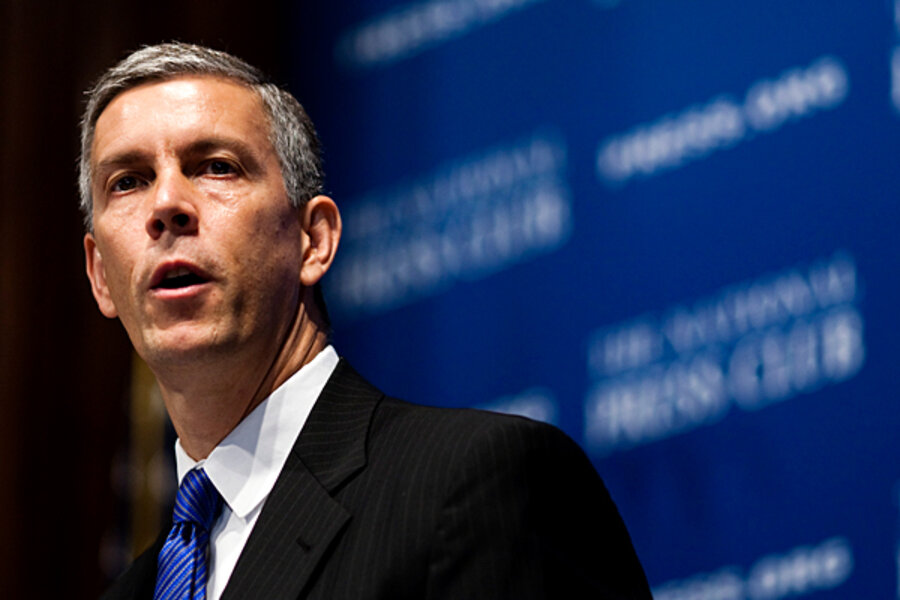As Race to the Top competition intensifies, so do education reforms
Loading...
Eighteen states and the District of Columbia are finalists in the second round of Race to the Top, the influential and controversial competition for federal money to help states overhaul their education systems.
In announcing the finalists in a speech to the National Press Club in Washington on Tuesday, Education Secretary Arne Duncan called Race to the Top part of “a quiet revolution” under way in education reform. He highlighted the reforms it’s already prompted states to put in place.
“This minor provision in the [stimulus package] has unleashed an avalanche of pent-up educational reform activity at the state and at the local level,” he said.
The finalists – which each received more than 400 points on a 500-point scale in evaluations – are Arizona, California, Colorado, District of Columbia, Florida, Georgia, Hawaii, Illinois, Kentucky, Louisiana, Maryland, Massachusetts, New Jersey, New York, North Carolina, Ohio, Pennsylvania, Rhode Island, and South Carolina. They’ll be competing for the $3.4 billion remaining in the program, and they will send teams in early August for the interview portion of the competition. The winners – somewhere between 10 and 15, according to Secretary Duncan – will be announced in September.
Perhaps the biggest surprise on that list is Arizona, which, in Round 1 of the competition, finished 40th out of 41 applicants.
“Arizona was a wild card. Coming in last apparently did not sit well with them,” says Charles Barone, director of federal policy for Democrats for Education Reform (DFER). Since the first round ended in the spring, he notes, Arizona has passed two major laws, increasing education funding and revamping the state’s teacher-evaluation system.
Race to the Top’s supporters have stressed that the biggest accomplishment of the program is that it spurs states trying to improve their applications to take on controversial reforms, even before spending any money. Since it was announced, 23 states have passed reform laws around things like charter schools and teacher evaluations to improve their chances of winning, according to the DFER. Just since Round 1, a number of states – including Colorado, Connecticut, Illinois, New York, Oklahoma, and Rhode Island – passed major reforms.
“States wouldn’t have stepped up the way they’ve stepped up without the competition,” Mr. Barone says. “That’s just the reality.”
But plenty of critics have said that this is the wrong time, with state education budgets strapped, to be holding a competition. They worry that the program puts too much emphasis on unproven strategies like charter schools, turnaround programs, and linking teacher evaluations to student performance.
On Monday, a coalition of civil rights groups, including the National Association for the Advancement of Colored People (NNACP) and the National Urban League, released a framework for education reform that criticized “the limited reach of the Race to the Top Fund and other market-based frames for federal education funding.”
It’s a charge Duncan takes issue with, noting in a conference call with reporters that the $4.3 billion total funds for Race to the Top represent less than 1 percent of all K-12 money spent each year. The reforms it is helping spur, he also noted, will be particularly important to low-income and minority students.
“We think the students that will benefit the most from higher standards are disadvantaged students,” said Duncan, who stresses that the administration will continue to work closely with civil rights leaders. He will speak at the National Urban League on Wednesday.
In Round 1, just two states – Delaware and Tennessee – ended up being selected as winners, surprising many observers. This time, Duncan has been clear that more states can expect to win, with a final number depending in part on the size of the states that wind up on top.
Collectively, the finalists have asked for $6.2 billion – far more than $3.4 billion available. They’re starting off further ahead than they were last time, Duncan says, with the average state having increased its application score by 26 points.
“We’re seeing this herculean amount of work,” he said.
Related:





